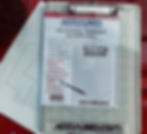5 Essential Tools for Property Adjusters
- Adjuster Prep
- May 3, 2024
- 3 min read
Property inspections are crucial for adjusters to evaluate damage and make accurate assessments for insurance claims. Whether it’s assessing storm damage, water leaks, or structural failures, having the right tools can greatly enhance the efficiency and accuracy of an adjuster's inspection process. Here are five essential tools every property adjuster should have in their toolkit.
1. Digital Camera or Smartphone Camera
Importance of Photographic Evidence
In the world of property adjusting, a picture is worth a thousand words — and potentially thousands of dollars. High-quality photos can provide irrefutable evidence of damage and help adjusters document the condition of a property both before and after an incident.
Choosing the Right Camera
While many professionals might prefer a high-resolution digital camera for its detailed images and optical zoom capabilities, a modern smartphone camera can often suffice. The key is to ensure the camera has sufficient megapixels (12 MP or higher), manual settings for different lighting conditions, and enough storage space to handle numerous high-quality photos. Additionally, features like a panoramic setting can be helpful for capturing the scope of room damage or large exterior areas.
2. Measure Tape or Laser Measure
Accurate Measurements for Accurate Claims
Accurate measurement is Essential for Property Adjusters and foundational in the property inspection process. Whether you're assessing the area of damaged flooring or the dimensions of a room for renovation, having the right measuring tool is essential.
Tape vs. Laser
A traditional tape measure is affordable and simple to use, making it a reliable choice for many. However, for larger or more complex spaces, a laser measure can be invaluable. Laser measures can quickly provide precise readings and often feature digital displays that store measurement data, which can be downloaded later for reports. They can be particularly useful in cluttered rooms or outdoor areas, where stretching a tape measure might be impractical.
3. Moisture Reader
Detecting Hidden Problems
Moisture within walls, floors, and ceilings can be a sign of deeper issues, such as leaks or water damage that has gone unnoticed. A moisture reader, or moisture meter, is critical for identifying these hidden problems before they result in serious damage.
Types of Moisture Meters
There are two main types of moisture meters: pin-type and pinless. Pin-type meters measure moisture content at the point of contact, while pinless meters can scan a larger area of the material without causing any damage. Depending on the typical scope of your inspections, you may choose one type or opt for both for greater flexibility.
4. Ladder
Reaching New Heights Safely
A ladder is indispensable for inspecting roofs, ceilings, and other high places safely and effectively. For property adjusters, accessing these areas is crucial for a thorough inspection, especially after events like storms.
Choosing the Right Ladder
For adjusters, a telescoping ladder that is lightweight yet sturdy is ideal. It should be easy to transport and quick to set up. Look for ladders that meet ANSI or OSHA standards to ensure safety and durability. Additionally, consider the typical height of properties you inspect to choose a ladder that will safely reach necessary areas without being overly cumbersome.
5. Notebook or Clipboard with Paper for Note Taking
The Value of Good Notes
While digital tools are invaluable, the role of taking good notes cannot be overstated in property inspection. Notes can track details that photos can’t capture, like smells, sounds, or the history of a property as explained by the owner.
Digital vs. Traditional
Some adjusters prefer the traditional pen and paper that a notebook or clipboard offers, as it does not rely on battery life and can be easily accessed at any time. For those more inclined to digital solutions, a tablet with a stylus can be used to make notes directly on photos, diagrams, or in digital forms. The choice depends on personal preference and the specific needs of the inspection process.

(Accu-line Sketch Pad is gridded with faint lines that aid in precise, scaled drawings.)
Conclusion Essential Tools for Property Adjusters
Equipping yourself with these five essential tools can significantly enhance your effectiveness and reliability as a property adjuster. By capturing detailed photos, taking precise measurements, identifying hidden moisture, safely accessing hard-to-reach places, and recording thorough notes, you can ensure that your inspections are comprehensive and your assessments accurate. This toolkit not only aids in the assessment process but also helps in building a credible case for any insurance claims, ultimately aiding property owners in their time of need.





